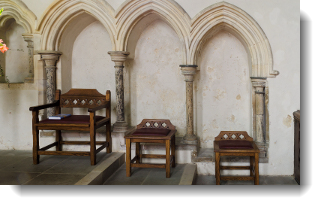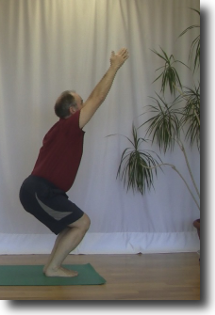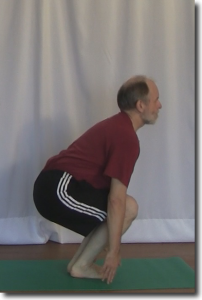“You are too old to be sitting in a high chair!” Alice told her niece as they sat down for lunch.
Recently Alice’s yoga teacher told her that she was too old to be sitting in a high chair in Utkatasana which is also know as chair pose.
What is Utkatasana
Utkatasana is one of the standing yoga poses. It appears in the second half of the standing series in Ashtanga Yoga.
Utkatasana is the Sanskrit name for the pose. Pronounced (OOT-kah-TAHS-anna) where Utkata means powerful or fierce in Sanskrit.
The pose goes by many English names besides Fierce pose. Some of the more common names are chair pose, zig zag pose and lightening bolt pose.
Regardless of the name you use for the pose it has many benefits. It strengthens your ankles, thighs, calves, and spine. At the other end of your torso you are stretching your shoulders and chest. At the same time you are stimulating your abdominal organs, diaphragm and heart.
Utkatasana is an easy pose to enter for the most part but it is challenging to hold for an extended period of time.
How to do Utkatasana
You start in Tadasana, standing tall at the top of your mat with your arms by your side and your big toes touching. There is a slight gap between your heels.
Exhale as you bend your knees and lower your hips towards the floor. Lean forward slightly as you lower your hips and raise your arms up over your head.
Bring your palms together. Ideally your wrists, shoulders and hips are in a straight line.
Lift your chin slightly look through your eyebrows towards the thumbs of your hands.
Descend your tail bone and tuck it between your legs. This will protect your lower back from being too compressed.
Drop your shoulder blades down your back away from your ears. This prevents stressing of the muscles around the base of your neck.
You are now in the pose. Hold here for several breaths.
One of the challenges in this pose as Alice discovered is getting out of the high chair and sitting lower down.
How to tell when you hips are in the right place
Lower your hands to the floor as your lower hips. this will tell you if your hips are low enough.
At the same time that you lower your hips towards the floor lower your hands too. Once your finger tips are touching the floor your hips are low enough.
Stop lowering your hips and raise your arms up until they are in line with your torso. Remember you want a straight line from your hips through your shoulders to your hands.
When you are touching the floor with your hands your torso will be at a 45 degree angle. If you find that you are tipping forward a lot more than this you need to take a different approach because your hips are being a challenge.
What to do if your hips won’t go low enough
Watch the angle of your torso as you lower your hips and hands towards the floor.
Once your hips stop descending and you start to tip forward then stop lowering your hands to the floor. Your hips are as far down as they can go. Raise your arms up and establish that straight line from your hips through your shoulders to your hands.
To get your hips to go lower use your Edge to increase their flexibility. As you breathe in let your hips rise slightly. As you exhale allow your hips to gradually descend until they can move no further. Do not try and push them beyond a comfortable but challenging stretch.
As you repeat this action of approaching your Edge each time you do the pose you will discover that your hips are getting a little lower. Eventually you will be able to touch the floor with your fingertips with your torso at a 45 degree angle.
Summary
Utkatasana is a fierce pose to accomplish if your hips are inflexible. It can be really difficult to get your hips in the right place.
Alice’s hips are getting more flexible. She is slowly getting out of her high chair.
Lowering your hands to the floor as you lower your hips will tell you if your hips are getting low enough. If you tip over before you touch the floor it is time to work with your Edge to improve your hip’s flexibility.
Next Steps
Ask your teacher to check your alignment in Utkatasana. They will help you to work with your Edge to improve the flexibility of your hips.
Additional Reading
Getting your arms in the right place in this pose can be a problem. The article How to work with your tuning fork arms in Utkatasana shows you how to work with this problem.
To avoid problems with your knees follow the advice in Why you should avoid the crevasse in Utkatasana.
Finally you can learn more about working with your Edge by reading these three articles






